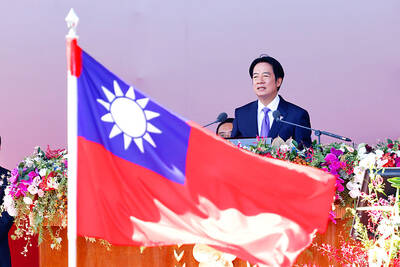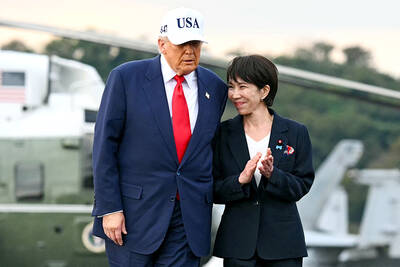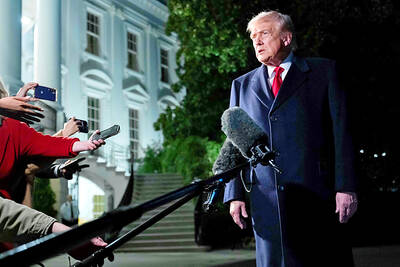Taipei and Beijing are still negotiating the “best timing” to submit the Economic Cooperation Framework Agreement (ECFA) document to the WTO, government officials said.
Chang Chun-fu (張俊福), deputy director of the Ministry of Economic Affairs’ (MOEA) Bureau of Foreign Trade, said both sides had translated the document into English, but had yet to decide when to notify the global trade body on the content of the pact.
“We are taking all things into consideration, but there is no time limit,” he said, adding that some countries took years to complete the process.
Earlier last week, the bureau’s ECFA Task Force told the Taipei Times it “would notify the ECFA to the WTO pursuant to the WTO’s rules and procedures,” adding that “as a usual practice, we will consult the other signatory before making any RTA [regional trade agreement] notifications.”
“Therefore, regarding the ECFA notification, we will discuss it with China and notify the WTO in due course,” it said.
Chang said that while the WTO does not set a time limit for the submission, it was understood that two to three years was not acceptable.
As the two sides have only completed negotiations on the “early harvest” program, more agreements needed to be negotiated after the ECFA was signed, Chang said.
However, he denied that the two sides would wait until a subsequent agreement under the ECFA framework was completed before sending a notification to the WTO.
Bureau of Foreign Trade chief secretary Chiang Wen-juo (江文若) said this approach was a “higher-level” decision and that she was in no position to offer any comment.
On Dec. 14, 2006, the General Council of the WTO established, on a provisional basis, a transparency mechanism for all RTAs that provides for the early announcement of any RTA — such as the ECFA — and notification to the WTO. Member economies are to consider the notified RTAs on the basis of a factual presentation by the WTO Secretariat.
The Committee on Regional Trade Agreements considers RTAs falling under Article XXIV of the General Agreement on Tariffs and Trade (GATT) and, if applicable, Article V of the General Agreement on Trade in Services.
The US government has expressed concerns over the fact that the ECFA documents signed by Taiwan and China in June last year have yet to be submitted to the WTO as promised, especially after the ECFA came into force on Sept. 12 and its early harvest list on Jan. 1.
Asked to comment on whether it was unusual for an RTA to come into force prior to notification to the WTO, Razeen Sally, co-director of the Brussels-based European Centre for International Political Economy and an expert on the WTO and preferential trade agreements, said WTO rules on the matter were not strictly regulated.
“Relevant WTO rules [in GATT Article XXIV] are not that strong, but, more to the point, are weakly policed and often honored in the breach,” Sally said by e-mail. “So if what you say is the case [failure to notify of an RTA prior to its entry into force], it is not that unusual.”
Furthermore, Sally said that in its current form, the ECFA covered less than ordinary RTAs.
“As it stands, [the ECFA] probably does not pass muster with Article XXIV, as it is a very partial agreement, eliminating tariffs on much, much less than the 90 percent of goods trade that is the WTO standard,” he said.
The 539 categories of traded goods included in the early harvest list account for about 16 percent of China-bound exports.
“[The] ECFA might eventually meet this standard, but that is to be decided, since it is a work in progress,” Sally said.
Minister of Economic Affairs Shih Yen-shiang (施顏祥) has said the English version would be sent to the WTO after the “supporting measures” of the Cross-Strait Economic Cooperation Committee (CSECC) were completed.
While the notification process usually takes more than a year, Shih said he hoped this could be accomplished as soon as possible.
The ECFA stipulates that once the trade pact takes effect, the two sides are to set up a cross-strait economic cooperation committee, and within six months initiate discussions on agreements on investment protection, commodity and service trades, as well as a dispute--resolution mechanism.
Taipei and Beijing formed the ad hoc CSECC earlier this month. Aside from negotiations, the purpose of the committee is to handle implementation, application and interpretation of the agreement or disputes resulting from it.
Under early harvest provisions, China has agreed to gradually lower tariffs on 539 categories of imports, with an estimated value of US$13.8 billion a year. Beijing also agreed to open 11 service categories and 18 farming and fishery categories to tariff reductions.
For their part, Chinese exporters will get a reciprocal deal on 267 items, with an estimated value of US$2.9 billion annually.
The administration has said the ECFA would help create 260,000 jobs and boost economic growth by as much as 1.7 percent, adding that the ECFA was crucial to ensure Taiwan was not marginalized following the entry into force of the ASEAN Plus Three (ASEAN plus China, Japan and South Korea).

PEACE AND STABILITY: Maintaining the cross-strait ‘status quo’ has long been the government’s position, the Ministry of Foreign Affairs said Taiwan is committed to maintaining the cross-strait “status quo” and seeks no escalation of tensions, the Ministry of Foreign Affairs (MOFA) said yesterday, rebutting a Time magazine opinion piece that described President William Lai (賴清德) as a “reckless leader.” The article, titled “The US Must Beware of Taiwan’s Reckless Leader,” was written by Lyle Goldstein, director of the Asia Program at the Washington-based Defense Priorities think tank. Goldstein wrote that Taiwan is “the world’s most dangerous flashpoint” amid ongoing conflicts in the Middle East and Russia’s invasion of Ukraine. He said that the situation in the Taiwan Strait has become less stable

Japanese Prime Minister Sanae Takaichi yesterday lavished US President Donald Trump with praise and vows of a “golden age” of ties on his visit to Tokyo, before inking a deal with Washington aimed at securing critical minerals. Takaichi — Japan’s first female prime minister — pulled out all the stops for Trump in her opening test on the international stage and even announced that she would nominate him for a Nobel Peace Prize, the White House said. Trump has become increasingly focused on the Nobel since his return to power in January and claims to have ended several conflicts around the world,

REASSURANCE: The US said Taiwan’s interests would not be harmed during the talk and that it remains steadfast in its support for the nation, the foreign minister said US President Donald Trump on Friday said he would bring up Taiwan with Chinese President Xi Jinping (習近平) during a meeting on the sidelines of the APEC Summit in South Korea this week. “I will be talking about Taiwan [with Xi],” Trump told reporters before he departed for his trip to Asia, adding that he had “a lot of respect for Taiwan.” “We have a lot to talk about with President Xi, and he has a lot to talk about with us. I think we’ll have a good meeting,” Trump said. Taiwan has long been a contentious issue between the US and China.

GLOBAL PROJECT: Underseas cables ‘are the nervous system of democratic connectivity,’ which is under stress, Member of the European Parliament Rihards Kols said The government yesterday launched an initiative to promote global cooperation on improved security of undersea cables, following reported disruptions of such cables near Taiwan and around the world. The Management Initiative on International Undersea Cables aims to “bring together stakeholders, align standards, promote best practices and turn shared concerns into beneficial cooperation,” Minister of Foreign Affairs Lin Chia-lung (林佳龍) said at a seminar in Taipei. The project would be known as “RISK,” an acronym for risk mitigation, information sharing, systemic reform and knowledge building, he said at the seminar, titled “Taiwan-Europe Subsea Cable Security Cooperation Forum.” Taiwan sits at a vital junction on